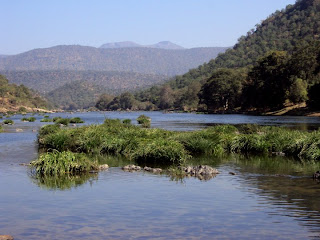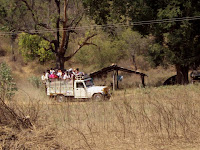 |
| Panoramic view of Belakere village |
Belakere, a small habitat inside the Cauvery North Wildlife Sanctuary with no metaled roads leading to / from it, is surrounded by ineffective Elephant Proof Trenches and houses a small Government Primary School where around 20-25 children go to study and get their free mid day meals. Barely 30-35 KM from Electronics City in Bangalore you would expect to be able to reach there by following Google Maps directions. But you can’t even find this place on Google Maps unless you know where to look for.
 |
| Elephant Proof Trench between Zero Point and Deverabetta |
I first got to know about the existence of such a village earlier this year when I joined as a volunteer of Kenneth Anderson Nature Society (an NGO committed to the conservation of the forests in Melagiris) in a survey of the Elephant Proof Trenches (EPT) dug up by the Tamil Nadu Forest Department to prevent the elephants from venturing out of the forests and into farm lands. These are deep and wide trenches that an elephant cannot cross. But the trenches tend to get silted up, or their walls can slide in, or some shepherd or cattle grazer can place logs across the EPT to gain access into the forests for their cattle, sheep and goats. Free fodder you see. That it is at the cost of taking away the food of the elephants and other herbivores of the jungle is not their issue. They don’t own farms which might get raided by the elephants after all. Thus these EPTs are made ineffective due to the breaches through which the pachyderms can come into human habitats and thus the survey was conducted to help the Tamil Nadu Forest Department find these breaches.
 |
| The road over the hills to Belakere (from Gummalapuram) |
Reaching Belakere is a tricky business. You can either walk, take a motorbike or take a four wheeler with a high ground clearance. Provided it has not rained. The terrain is hilly and the track is strewn with stones and soil. Lots of soil that can quickly turn in mush and stones that will be all wet and slippery in rains. And then there is the perennial danger of crossing paths with the elephants. Interestingly though, electricity reaches Belakere!
 |
| Our rides into the jungles to reach Belakere |
So we, a bunch of volunteers from KANS, some children from TVS Academy, Hosur and their teacher, went to Belakere in two Tata Safaris, a Chevrolet Tavera and a Mahindra Scorpio after parking the hatchbacks in the Gummalapuram high school from where we were joined by the headmasters and the circle head for the National Green Corps. We drove very slowly and carefully since there was lot of loose soil and stones on the paths, with deep narrow gullies formed by the water from the rains in last two months since we went there for a recce.
| Children of Belakere Panchayat Primary School |
The children all welcomed us with their loud sing song chorus of “Good morning Sir” and there was a brief intro. There were less than 25 mixed age group children in total, with a few under aged children too, probably since there was no anganwadi (govt. preschool cum creche) in the village. It is a common practice nevertheless in the hinterlands to send the young child along with their older sibling(s).
| Forming teams for the nature walk |
We started the day’s program with a nature walk wherein groups of children were formed, each with 4-5 children, led by a student each of TVS Academy, Hosur. The children from both the schools introduced themselves to each other and they were explained what was to be done. Unsurprisingly, the children all mingled within minutes and were eager to head out.
| A stroll through the woods |
The objective was to take a nice leisurely stroll through the village, their farms and thereon to the edges of the forest to collect leaves, twigs, fruits, flowers, interesting stones, etc. that the children find along the paths they walk through.
| The children with their collection. |
The children led us all through their village and I asked them to identify a few birds which were either flying nearby or calling from afar. And they collected quite a good lot of stuff only children have the innocent curiosity to find interesting. 🙂
After coming back to the school the teams started making things out of the stuff they picked up. A tree out of twigs and leaves, a camp site, etc. And by this time the children had broken ice with the all of us and were quite enjoying all the attention and novelty. And then it was time for all the adults to admire their creations. 🙂
| Pictures of Flora & Fauna on a lanyard being distributed to the participants. |
This was the perfect time to rope in all the adults present for the next activity, Web of Life. Everybody, including the adults, were asked to stand in a big circle and each one of them was given a chart with the picture of a tree/plant/grass or animal/insect/fish/bird on it, with a lanyard to wear round the neck.
It was so beautiful to see the elder children helping the younger ones put the lanyards round their necks. There was a lot of laughing when even the teachers, headmasters, forest department staff and KANS volunteers started wearing the charts.
| The oldest and the youngest members of the Web of Life! |
The highlight was the octogenarian joining the game and standing right next to the youngest of them all, who incidentally got an Elephant. There was quite some cheering and laughing at that. 🙂
Children were then asked to identify the flora & fauna they had all got. And then beginning with plants, the children were asked what/who ate (preyed on) them. At this point a spool of twine was passed around to connect the food to its consumer. From the flora we moved onto the eaters of the herbivores, and so on until we connected every living thing to the other as a web.
 |
| The big Web of Life. |
Soon we had a huge web of crisscrossing twine and everybody could see how we were all interconnected. Fabulously too! And now came the final act. To show the grim consequences of the dastardly acts of man to rip out the forests in the name of progress.
| When man destroys the forests, the Web of Life begins to shrink. |
First the children representing the trees and plants were asked to leave their end of the twine and sit down. Next children were asked to identify which are the animals that could no longer survive due to unavailability of their food. Now these children had to leave their end of the twine and sit down. And after that the animals dependent on these felled animals. Soon nothing much was left except the tiger and man. Top predators of the food chain. And without food, they too perish. A serious concept very beautifully explained to the children. And when asked what they learnt from this activity, pat came the response – forests are our life. Mission accomplished!
| Quiz in progress |
There was a lunch break where free mid day meals, cooked in the school premises, was served to the children. Post this Girish, our project lead, conducted a short quiz where the children identified different animals, birds, reptiles shown on the laptop screen. A correct answer was rewarded with a Cadbury’s Dairy Milk chocolate. And soon everybody had a chocolate in hand. 😉
| The returning TVS Academy, Hosur team. |
This was immediately followed by a movie show on Nagarhole National Park that ran for an hour. And then it was time for the team from TVS Academy, Hosur, to leave after enriching the lives of us all. Thank yous were exchanged and byes were told.
| KANS President Sanjeev distributing the books to the children. |
Finally Sanjeev, president of KANS, distributed a book on animals in Kannada to all the children. A few were given to the headmaster of Gummalapuram school to be kept in their library.
 |
| Ragi mudde, saaru – our lunch |
But that was not all, we were invited by a village resident for a sumptuous lunch of Ragi Mudde (huge balls made of boiled flour of millets) and saaru (spiced up stock of boiled leaves) along with avarekai palya (fried beans and leaves tempered with seasonings). And then it was time to disperse. We KANS members stopped for a while in the jungle for our committee meeting, on a lookout for elephants which were apparently being driven over to Tamil Nadu side by the Karnataka Forest Department, we did hear loud crackers being burst. Then we went to the Gummalapuram school to pick up our vehicles and dispersed from there with promises to take this model to other schools in the Melagiris.
Originally published at http://sfh.naasat.in/2014/12/web-of-life.html






















